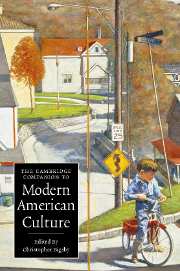Book contents
- Frontmatter
- 1 Introduction: What, then, is the American?
- 2 The American century
- 3 The regions and regionalism
- 4 Immigration to the United States in the twentieth century
- 5 Religion in the United States in the twentieth century: 1900-1960
- 6 Shifting boundaries: religion and the United States: 1960 to the present
- 7 The Hispanic background of the United States
- 8 African Americans since 1900
- 9 Asian Americans
- 10 Women in the twentieth century
- 11 Queer America
- 12 The United States, war, and the twentieth century
- 13 The culture of the Cold War
- 14 Secret America: the CIA and American culture
- 15 Vietnam and the 1960s
- 16 New York City and the struggle of the modern
- 17 Music: sound: technology
- 18 African American music of the twentieth century
- 19 Hollywood cinema
- 20 Popular culture
- 21 Theatre
- 22 Society and the novel in twentieth-century America
- 23 “Preferring the wrong way”: mapping the ethical diversity of US twentieth-century poetry
- Index
- Series List
10 - Women in the twentieth century
Published online by Cambridge University Press: 28 January 2007
- Frontmatter
- 1 Introduction: What, then, is the American?
- 2 The American century
- 3 The regions and regionalism
- 4 Immigration to the United States in the twentieth century
- 5 Religion in the United States in the twentieth century: 1900-1960
- 6 Shifting boundaries: religion and the United States: 1960 to the present
- 7 The Hispanic background of the United States
- 8 African Americans since 1900
- 9 Asian Americans
- 10 Women in the twentieth century
- 11 Queer America
- 12 The United States, war, and the twentieth century
- 13 The culture of the Cold War
- 14 Secret America: the CIA and American culture
- 15 Vietnam and the 1960s
- 16 New York City and the struggle of the modern
- 17 Music: sound: technology
- 18 African American music of the twentieth century
- 19 Hollywood cinema
- 20 Popular culture
- 21 Theatre
- 22 Society and the novel in twentieth-century America
- 23 “Preferring the wrong way”: mapping the ethical diversity of US twentieth-century poetry
- Index
- Series List
Summary
American women's lives changed in many crucial respects over the course of the twentieth century. In 1900, domesticity framed most women's lives; few obtained education after the age of fourteen. Yet while almost all white women left the formal labor force after marriage, many African American women remained economically active throughout their adult lives. The vast majority of women married by the age of twenty-two or twenty-three, and stayed with their partner until he died. Divorce was a rarity. The average woman had four children. She typically survived the departure from home of her youngest child by only a handful of years, so living alone was a rarity. Many women participated in social and political events outside the home, even though only a small number could vote, mostly in local elections and some western states. Few women held public office, yet they worked effectively outside the political mainstream in various reform movements and voluntary activities.
By 2000, economic activity throughout adulthood has become the norm, with a shift in predominant occupations from domestic service and factory labor to paper-based employments in the professions and offices of the country. While domesticity still figures in the female experience, especially when children are young, few women remain outside the labor force entirely, and race and marital status have less affect on employment rates. Education levels have skyrocketed for women as well as men from every race and ethnic group. Almost all young women graduated from high school in 2000 and about half entered higher education.
- Type
- Chapter
- Information
- The Cambridge Companion to Modern American Culture , pp. 194 - 214Publisher: Cambridge University PressPrint publication year: 2006



